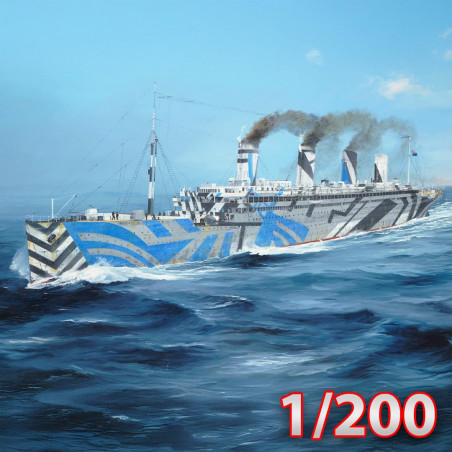

















-
-€100.00
-
Promotion
-
Novelty
Dimensions of the Assembled Model:

Plastic Model Ship H.M.T. OLYMPIC 1:200
Plus de detailsPlastic Model Ship H.M.T. OLYMPIC 1:200
|
|

|
Plastic boat model lighting kit for OLYMPIC 95T03720€36.95 - ref. 95T06655 |
Model of the sister-ship of the famous TITANIC, which was requisitioned by the army during the war.
Additional information of the TRUMPETER plastic kit :
Optional lighting kit available under part no. 95T06655
The British shipping company White Star Line, founded in 1845, decided at the beginning of the 20th century to build a new series of ocean liners to strengthen its transatlantic routes. The first of this series was the Olympic.
Its name evokes the prestige of antiquity and also symbolizes the year of its construction: 1908, the year of the London Olympic Games and the start of construction on this massive liner.
In the Belfast shipyards, the Olympic’s keel was laid on December 16, 1908. Less than four months later, the construction of its twin, the Titanic, began at the same site. The two ships, assembled side by side, each measured 269 meters in length.
The brand-new liner was equipped with luxurious facilities, including multiple lounges, libraries, as well as sports and relaxation facilities such as a gymnasium, squash court, swimming pool, and Turkish baths.
The Olympic gave its name to the famous Olympic Class, which included the three White Star Line ships: the Olympic, the Titanic, and the Britannic.
In June 1911, the Olympic made its maiden voyage, taking five days to travel from Southampton to New York, with Captain Edward Smith at the helm. He would later command the Titanic and perish during its sinking in 1912.
The Olympic’s first crossings were marked by several incidents, including a collision with the British warship, the Hawke, in November 1911. On February 24, 1912, a storm damaged the Olympic, breaking one of its propeller blades. White Star Line then decided to use parts initially intended for the Titanic to repair the Olympic, which delayed the Titanic’s maiden voyage from March 20 to April 10, 1912.
During the Titanic’s tragic sinking on April 15, 1912, the Olympic, en route from New York to Southampton, was located 500 miles from its twin. Too far to render immediate assistance, the Olympic used its radio signals to relay the distress call.
Following the Titanic disaster, the Olympic underwent a series of tests, and modifications were made to enhance its safety. It then resumed commercial service until it was requisitioned by the British Army during World War I.
After the armistice, it returned to ocean crossings, transporting numerous travelers, celebrities, and royalty. However, competition and a challenging economic context ended its career in 1934, and the Olympic was dismantled in 1937, the same year Pierre de Coubertin passed away.
Several decorative elements from the Olympic were saved through an auction. Director James Cameron even drew inspiration from certain details and relics of the Olympic for his film Titanic (1997).
The main distinguishing factor between the Titanic and the Olympic in 1912 was their tonnage: the Titanic weighed 1,000 tons more than the Olympic. However, after the Titanic’s sinking, the Olympic was strengthened for added safety, making its tonnage exceed that of the Titanic.
The differences between the Titanic and the Olympic, while subtle at first glance, involved their initial design, structure, and operational history, each marked by distinct maritime events.
Design and Technical Characteristics:
The Titanic and the Olympic were part of the Olympic Class, built by White Star Line in the early 20th century to enhance transatlantic routes.
Though the two liners appeared almost identical and each measured 269 meters long, the Titanic, built after the Olympic, was slightly more massive, with a gross tonnage of approximately 46,328 tons compared to the Olympic’s 45,324.
This added weight allowed the Titanic to include enhanced facilities and an extra level of luxury over its predecessor.
Structural and Interior Differences:
The interior differences between the Titanic and the Olympic were most noticeable in certain first-class spaces.
For example, the Titanic featured more lavish suites, an exclusive Parisian restaurant, and an elegant enclosed promenade on the first-class deck, not present on the Olympic in the same dimensions.
These improvements aimed to make the Titanic even more appealing to wealthy clients, reinforcing its image as a floating palace. The Titanic also had additional windows in some lounges to increase natural light, while the Olympic featured only portholes in those areas.
Safety and Hull Structure:
Though designed to be the safest of their time, both the Titanic and the Olympic had structural weaknesses. The Titanic had 16 watertight compartments, an innovative feature, but lacked sufficiently high watertight bulkheads above the waterline, which could have improved safety in the event of a breach.
After the Titanic’s sinking in April 1912, the Olympic underwent major safety upgrades. Its hull was reinforced, bulkheads were raised, and the number of lifeboats was increased to match maximum passenger and crew capacity. These changes allowed the Olympic to operate safely for many years after the Titanic disaster.
Distinct Operational Histories:
Launched in 1911, the Olympic had a much longer and eventful career than the Titanic. In November 1911, it collided with the British warship Hawke, causing significant damage.
In 1912, it suffered further damage by losing a propeller blade, requiring White Star Line to use parts from the Titanic for repairs, delaying the Titanic’s maiden voyage.
In contrast, the Titanic sank on its first crossing in April 1912 after striking an iceberg, leading to over 1,500 casualties. Following this tragedy, the Olympic was modified and continued to operate, even serving as a troop carrier during World War I, before resuming commercial service post-war until its retirement in 1937.
Legacy:
The Titanic is widely remembered today for its tragic end, which turned it into a legend, while the Olympic, despite its notable career, is often overlooked. However, the Olympic inspired several elements in James Cameron’s Titanic film, and some of its decorative features were preserved during its dismantling.
The main visible difference between the two liners remained their tonnage and the safety modifications made after the Titanic’s loss.
Customers who bought this product also bought: